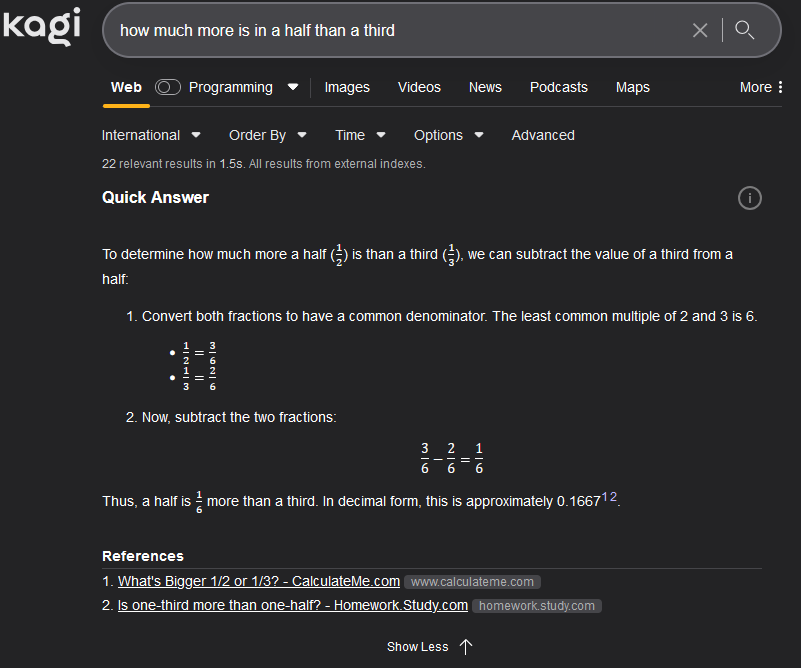

Ah, you’re right - I misunderstood jbrain’s point to just be about the “relative to the original” understanding. Guess I’m no smarter than Google’s AI.
New account since lemmyrs.org went down, other @Deebsters are available.


Ah, you’re right - I misunderstood jbrain’s point to just be about the “relative to the original” understanding. Guess I’m no smarter than Google’s AI.


Yes, and the Google AI response is correct (and quite clear) in what it says. edit: Thanks Batman. I mean that Google’s understanding of the question is logical (although still the maths is wrong as you say (now I’ve re-read you)) and its answer explained the angle it was answering from.
However, I think the reasonable assumption for the intention behind the question is relative to a whole. I had third of a pizza, and now I have an extra sixth of a pizza. It’s subtle, but that’s the kind of thing AI falls down on.


Google’s AI seems dumber than the rest, for example here’s Kagi answering the same (using Claude):

edit: typoed question originally
Perhaps Google’s tried to make it run too cheaply - Kagi’s one doesn’t run unless you ask for it, and as a paid product it’ll have different priorities.


While I don’t disagree, this article is pretty bad and unconvincing. Is it a draft or something dashed out to collect referral fees?


sweet stop
I think you mean sweet spot. Now I’m wondering if it’s a typo or an eggcorn.
It shows the top line, so you just read top to bottom (and can scroll if you want).
You can set it to show what you want; if I’m doing TDD I’ll set it to show the test output, and then it’ll show the warnings beneath it.
You can switch between the views with a key (T for tests (or N for nextest), C for clippy, etc
But yes, it’s pretty similar to using watch.
My hope is that something like Servo gets good enough to be included, especially if it’s tree-shakable so you can only include a subset of the codebase. I don’t know if that’s a goal for either projects, but it would be cool - the default webviews can be quite lacking so currently you need to use a restricted set of HTML/CSS/JS to guarantee compatibility.
My (ISO) keyboards do, under the Esc key. I guess you’re in North America (or Australia) and have an ANSI layout.


Ah yeah, missed that 🤦♂️


Because this is the internet, I can’t tell if the whoosh goes to your downvoters or you. I think you were joking, but that second sentence makes me wonder…


I pay for Nebula - $30 a year which is about £22.50. That won’t even cover two months of YouTube Premium (£12 pm), and there’s not even the discounted yearly option in the UK.
And “if you’re not paying you’re the product” is wrong - YouTube/Google would still be datamining my viewing habits to sell to advertisers.


100% the second one. It’s the idiomatic way to do this in Rust, and it leaves you with an immutable object.
I personally like to move the short declarations together (i.e. body down with language_id (or both at the top)) but that’s a minor quibble.


Perhapsburg they are


Only if enough people do it. Then again, loads scrapers outside of AI already pretend to be normal browsers.


The term you want is “cross compile”. I’ve developed simple programs for the Pi on Windows and it’s simple enough to produce a static binary (using Rust, anyway). When extra dependencies come in it’s better to develop on the same OS, but targeting different architectures is the easy bit.


Token-based string distances looks like exactly what I need for my current side project - I’m using Levenshtein but I should be comparing based on words, not characters.
I just need to figure out which (if any) of these does what I need.
Edit: looks like the Python version has that information: https://github.com/life4/textdistance?tab=readme-ov-file#algorithms


stacking prefixes is disallowed (e.g. 10 k km), and because using mega is both correct and more concise (e.g. 10 Mm).
If you’re talking distances and you say Mm, I’m far more likely to assume you mean millimetres. It might be technically correct, but it’s bad communication.


How did you find Leptos to work with? I never got further than the tutorial so I have yet to form a real opinion on it.
I thought we were finally agreeing fully! My understanding of the question is “what is the difference between a third (of a pizza, say) and a half?”
1/2 - 1/3 = 1/6
1/2 = 1/3 + 1/6
a half is one sixth more than a third.
btw, I fixed my Kagi screenshot since I’d missed a word from the question (reading comprehension’s clearly not my strong point today)